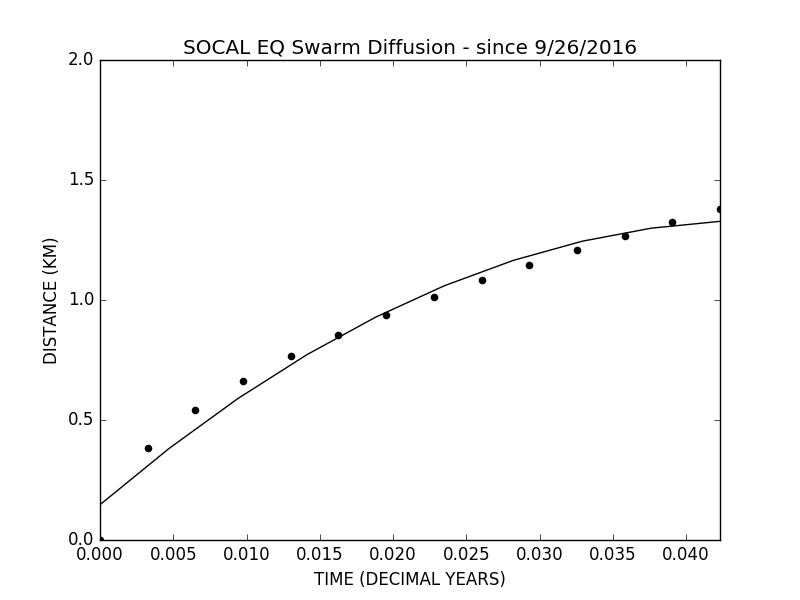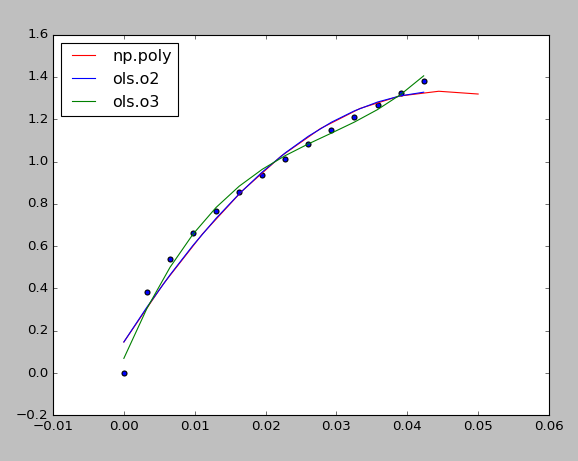我正在尝试拟合具有零截距的二阶函数。现在,当我绘制它时,我得到一条 y-int > 0 的线。我试图适应该函数输出的一组点:
y**2 = 14.29566 * np.pi * x
或
y = np.sqrt(14.29566 * np.pi * x)
两个数据集 x 和 y,其中 D = 3.57391553。我的试衣习惯是:
z = np.polyfit(x,y,2) # Generate curve coefficients
p = np.poly1d(z) # Generate curve function
xp = np.linspace(0, catalog.tlimit, 10) # generate input values
plt.scatter(x,y)
plt.plot(xp, p(xp), '-')
plt.show()
我也尝试过使用statsmodels.ols:
mod_ols = sm.OLS(y,x)
res_ols = mod_ols.fit()
但我不明白如何为二阶函数(而不是线性函数)生成系数,也不明白如何将 y-int 设置为 0。我看到另一篇类似的文章涉及强制 y-int 为 0具有线性拟合,但我无法弄清楚如何使用二阶函数来做到这一点。
现在的剧情:

数据:
x = [0., 0.00325492, 0.00650985, 0.00976477, 0.01301969, 0.01627462, 0.01952954, 0.02278447,
0.02603939, 0.02929431, 0.03254924, 0.03580416, 0.03905908, 0.04231401]
y = [0., 0.38233801, 0.5407076, 0.66222886, 0.76467602, 0.85493378, 0.93653303, 1.01157129,
1.0814152, 1.14701403, 1.20905895, 1.26807172, 1.32445772, 1.3785393]
最佳答案
如果我理解正确,您想用OLS拟合多项式回归线,您可以尝试以下操作(正如我们所见,随着拟合多项式的次数增加,模型会过度拟合数据越来越多):
xp = np.linspace(0, 0.05, 10) # generate input values
pred1 = p(xp) # prediction with np.poly as you have done
import pandas as pd
data = pd.DataFrame(data={'x':x, 'y':y})
# let's first fit 2nd order polynomial with OLS with intercept
olsres2 = sm.ols(formula = 'y ~ x + I(x**2)', data = data).fit()
print olsres2.summary()
OLS Regression Results
==============================================================================
Dep. Variable: y R-squared: 0.978
Model: OLS Adj. R-squared: 0.974
Method: Least Squares F-statistic: 243.1
Date: Sat, 21 Jan 2017 Prob (F-statistic): 7.89e-10
Time: 04:16:22 Log-Likelihood: 20.323
No. Observations: 14 AIC: -34.65
Df Residuals: 11 BIC: -32.73
Df Model: 2
Covariance Type: nonrobust
==============================================================================
coef std err t P>|t| [95.0% Conf. Int.]
------------------------------------------------------------------------------
Intercept 0.1470 0.045 3.287 0.007 0.049 0.245
x 52.4655 4.907 10.691 0.000 41.664 63.267
I(x ** 2) -580.4730 111.820 -5.191 0.000 -826.588 -334.358
==============================================================================
Omnibus: 4.803 Durbin-Watson: 1.164
Prob(Omnibus): 0.091 Jarque-Bera (JB): 2.101
Skew: -0.854 Prob(JB): 0.350
Kurtosis: 3.826 Cond. No. 6.55e+03
==============================================================================
pred2 = olsres2.predict(data) # predict with the fitted model
# fit 3rd order polynomial with OLS with intercept
olsres3 = sm.ols(formula = 'y ~ x + I(x**2) + I(x**3)', data = data).fit()
pred3 = olsres3.predict(data) # predict
plt.scatter(x,y)
plt.plot(xp, pred1, '-r', label='np.poly')
plt.plot(x, pred2, '-b', label='ols.o2')
plt.plot(x, pred3, '-g', label='ols.o3')
plt.legend(loc='upper left')
plt.show()
# now let's fit the polynomial regression lines this time without intercept
olsres2 = sm.ols(formula = 'y ~ x + I(x**2)-1', data = data).fit()
print olsres2.summary()
OLS Regression Results
==============================================================================
Dep. Variable: y R-squared: 0.993
Model: OLS Adj. R-squared: 0.992
Method: Least Squares F-statistic: 889.6
Date: Sat, 21 Jan 2017 Prob (F-statistic): 9.04e-14
Time: 04:16:24 Log-Likelihood: 15.532
No. Observations: 14 AIC: -27.06
Df Residuals: 12 BIC: -25.79
Df Model: 2
Covariance Type: nonrobust
==============================================================================
coef std err t P>|t| [95.0% Conf. Int.]
------------------------------------------------------------------------------
x 65.8170 3.714 17.723 0.000 57.726 73.908
I(x ** 2) -833.6787 109.279 -7.629 0.000 -1071.777 -595.580
==============================================================================
Omnibus: 1.716 Durbin-Watson: 0.537
Prob(Omnibus): 0.424 Jarque-Bera (JB): 1.341
Skew: 0.649 Prob(JB): 0.511
Kurtosis: 2.217 Cond. No. 118.
==============================================================================
pred2 = olsres2.predict(data)
# fit 3rd order polynomial with OLS without intercept
olsres3 = sm.ols(formula = 'y ~ x + I(x**2) + I(x**3) -1', data = data).fit()
pred3 = olsres3.predict(data)
plt.scatter(x,y)
plt.plot(xp, pred1, '-r', label='np.poly')
plt.plot(x, pred2, '-b', label='ols.o2')
plt.plot(x, pred3, '-g', label='ols.o3')
plt.legend(loc='upper left')
plt.show()
关于python - 如何强制零截距来拟合二阶函数? (Python),我们在Stack Overflow上找到一个类似的问题: https://stackoverflow.com/questions/41771283/

